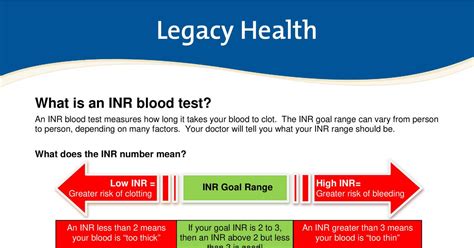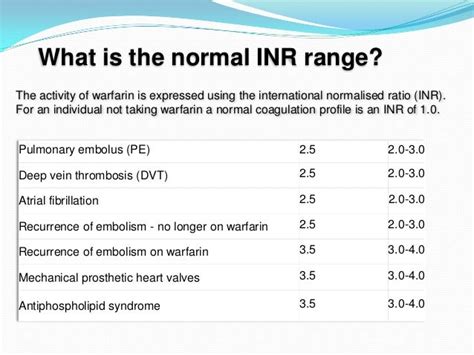Intro
Discover the importance of a normal INR range and its impact on blood clotting. Learn 5 ways to maintain a healthy INR range, preventing thrombosis and embolism, and understand the role of anticoagulation therapy and vitamin K in INR management.
Maintaining a normal International Normalized Ratio (INR) range is crucial for individuals taking anticoagulant medications, such as warfarin. The INR test measures the time it takes for blood to clot and is used to determine the effectiveness of these medications. A normal INR range typically falls between 2.0 and 3.0, although this can vary depending on the individual's condition and the specific medication being taken.
For people on anticoagulant therapy, understanding the importance of maintaining a normal INR range is vital. It helps prevent both thromboembolic events, which can occur if the INR is too low, and bleeding complications, which can happen if the INR is too high. Furthermore, maintaining a stable INR range can also reduce the risk of other health issues associated with abnormal blood clotting.
The management of INR levels involves regular blood tests, dietary adjustments, and adherence to the prescribed medication regimen. Healthcare providers closely monitor patients' INR levels to adjust their medication doses as needed. This personalized approach ensures that the benefits of anticoagulation therapy are maximized while minimizing the risks.
Understanding INR and Its Importance

Understanding what INR measures and how it affects the body is essential for managing anticoagulant therapy effectively. The INR is a calculation based on the results of a PT (Prothrombin Time) test, which measures how long it takes for the blood to clot. This calculation helps standardize the results, allowing for more accurate comparisons across different laboratories. An INR within the therapeutic range indicates that the blood is clotting at the desired rate, reducing the risk of both clotting and bleeding.
Factors Influencing INR Levels
Several factors can influence INR levels, including diet, other medications, and lifestyle changes. For instance, consuming foods high in vitamin K, such as leafy green vegetables, can affect warfarin's efficacy and thus the INR level. Similarly, certain medications and supplements can interact with anticoagulants, altering their effectiveness. Being aware of these factors and making appropriate adjustments can help maintain a stable INR range.Maintaining a Normal INR Range

Maintaining a normal INR range involves a combination of regular monitoring, dietary management, and adherence to medication. Here are some key strategies:
- Regular Monitoring: Regular INR tests are crucial to ensure that the blood is clotting within the desired range. The frequency of these tests can vary based on the individual's stability and the healthcare provider's recommendations.
- Dietary Management: Being mindful of vitamin K intake is important for individuals on warfarin. While it's not necessary to completely avoid vitamin K-rich foods, maintaining a consistent intake can help stabilize INR levels.
- Medication Adherence: Taking anticoagulant medications as prescribed is vital. Missing doses or taking extra doses can lead to INR levels that are too high or too low, increasing the risk of complications.
Benefits of a Stable INR Range
A stable INR range offers several benefits, including reduced risks of stroke, pulmonary embolism, and other thromboembolic events. It also minimizes the risk of bleeding complications, which can be severe. Furthermore, maintaining a stable INR can improve the overall quality of life for individuals on anticoagulant therapy, allowing them to engage in daily activities with confidence.Challenges in Managing INR Levels

Despite the importance of maintaining a normal INR range, several challenges exist. These include:
- Dietary Interactions: As mentioned, certain foods can interact with anticoagulants, making it challenging to maintain a stable INR.
- Medication Interactions: Other medications and supplements can also affect INR levels, requiring careful management.
- Lifestyle Changes: Travel, changes in diet, or other lifestyle adjustments can impact INR stability, necessitating close monitoring.
Strategies for Overcoming Challenges
To overcome these challenges, individuals can: - Keep a diary to track INR results, medication intake, and any dietary changes or interactions. - Communicate openly with healthcare providers about any changes or concerns. - Educate themselves and their families about anticoagulant therapy and INR management.Technological Advances in INR Management

Recent technological advances have improved INR management. For example, point-of-care INR testing devices allow individuals to monitor their INR levels at home, reducing the need for frequent clinic visits. Additionally, mobile applications and online platforms can help track INR results, medication adherence, and dietary intake, facilitating more personalized and effective management of anticoagulant therapy.
Future Directions in INR Management
Future directions in INR management may include more sophisticated monitoring technologies, such as wearable devices that can continuously monitor blood clotting, and personalized medicine approaches that tailor anticoagulant therapy to an individual's genetic profile and lifestyle. These advancements hold promise for improving the safety and efficacy of anticoagulation therapy.Conclusion and Next Steps

In conclusion, maintaining a normal INR range is critical for individuals on anticoagulant therapy. By understanding the factors that influence INR levels, being aware of the challenges in managing INR, and leveraging technological advances, individuals can work closely with their healthcare providers to achieve and maintain a stable INR range. This not only reduces the risk of complications but also improves the quality of life.
We invite you to share your experiences with INR management and anticoagulant therapy. Your insights can help others understand the importance of maintaining a normal INR range and the strategies that work best for managing this aspect of their health.
What is a normal INR range for individuals on anticoagulant therapy?
+A normal INR range typically falls between 2.0 and 3.0, although this can vary depending on the individual's condition and the specific medication being taken.
How often should INR levels be monitored?
+The frequency of INR monitoring can vary based on the individual's stability and the healthcare provider's recommendations. Regular monitoring is crucial to ensure that the blood is clotting within the desired range.
What are the benefits of maintaining a stable INR range?
+Maintaining a stable INR range reduces the risks of stroke, pulmonary embolism, and other thromboembolic events, as well as minimizes the risk of bleeding complications, improving the overall quality of life for individuals on anticoagulant therapy.
